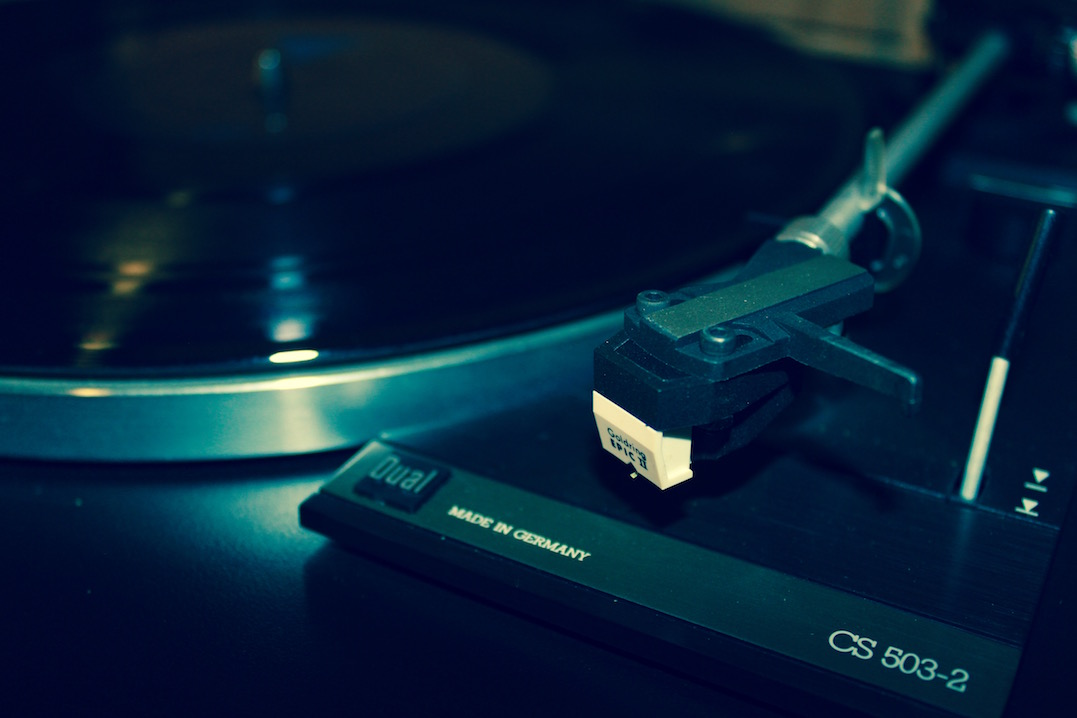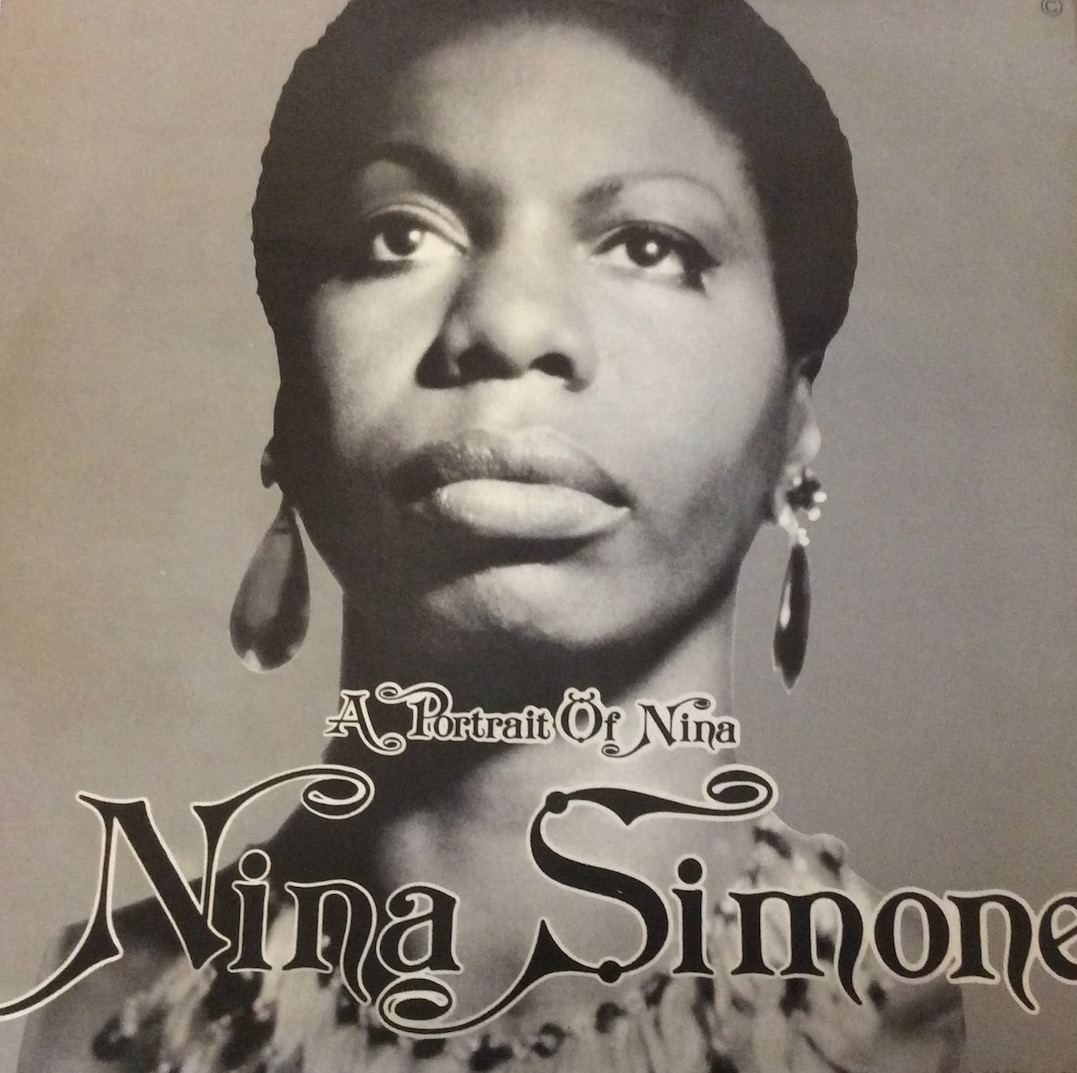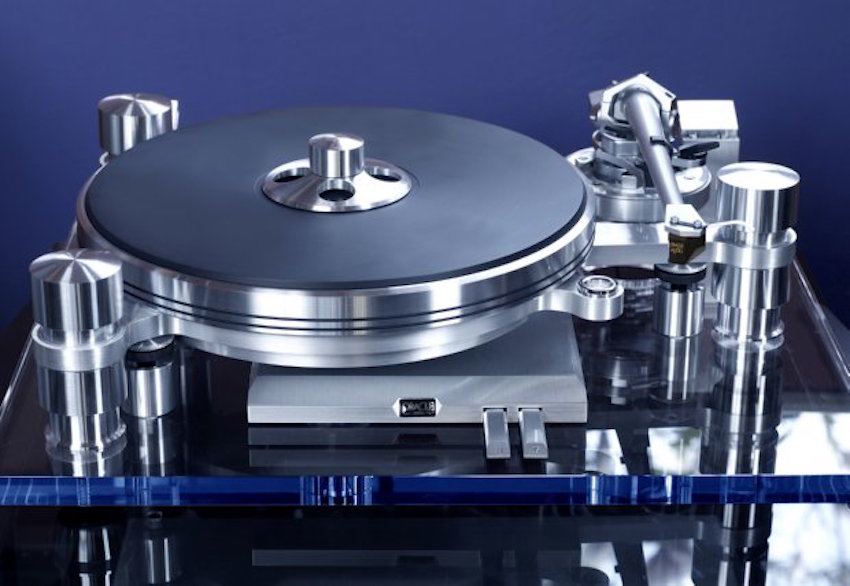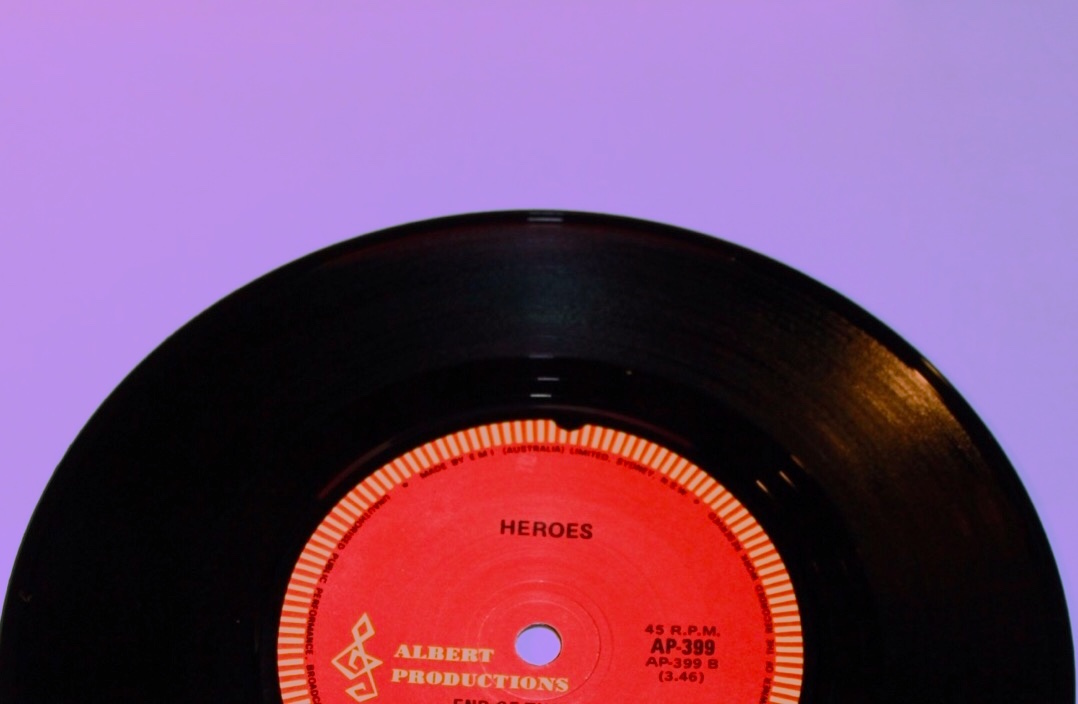Let us enter a strange and seductive world, fraught with peculiar devices, great expense, pain, mystery and rapturous pleasures. I do not mean a world of dim red-lit ill-smelling rooms crowded with people in plastic masks and underpants with too many zippers in the wrong places. That would be a completely different adventure.
I am of course talking about adventures in hunting, collecting, admiring, listening to and trading records. You know, the black wax, the platters, the big shiny discs from which riders on the merry-go-round of music get half their name.
For me this consuming adventure began with finding a cheap plastic turntable in an op shop. Under the brand name Masuda, this small black rectangular object featured a little window in the front where you could watch little dots whizz past, one row for 60hz, below that another for 50hz. I understood this had something to do with a variable pitch control wheel, a gadget to adjust the rotational speed of the platter to perfection. Gadgets, spinning wheels, technicalities, flashing lights. I was mesmerized, I was hooked. Of course the cool, the suave, the charm, the process of music had something to do with it as well.
Let’s go back to the beginning. They say in ancient times potters spinning clay vessels on a wheel and inscribing them with a fine decorative spiral with a pointed stylus – a drawing or writing instrument – inadvertently recorded the ambient sound and voices in their workshops onto the clay. I don’t know if this is true or just a combination of wishful thinking and projection. A little like Raudive ghost tapes, a technique by which Latvian researcher Konstantin Raudive hooked up a resistor to the recording head of a reel to reel tape recorder; in playback of the ensuing white noise many people claimed to hear responses from the voices of the dead. Perhaps more likely to be a combination of suggestion and projection; in clouds we see faces, in static voices. One of those deeply programmed survival traits that goes back to infancy, when the need to identify a parent’s voice or face in our helplessness is paramount.
Somewhere between the two, Thomas Edison, the old pirate, invented a device for vibrational inscribed recording and playback on paper, tinfoil and then wax cylinders. The form a fairly natural progression from music boxes and player pianos, and apparently one of the few inventions Edison didn’t pilfer from European inventors and patent in the US under his own name. The Edison Phonograph, the recording and instant playback of sound and music, was the beginning of something big. The shape and the machinery have changed, but the essentials are still the same. The name wax stuck even when the material changed to vinyl. The names record and album (from a large folder like a photo album in which people used to keep their records) stuck even when the material changed from vinyl to aluminium and polycarbonate, and disappeared altogether into an infinite digital ether (perhaps Raudive was right after all). However that’s a story for a more in-depth and factual researcher. This is a personal story about record collecting. So I better start at my beginning.
The first record I had was gift, back in the dark ages when rock was the voice of the people and an art form in itself, and disco entertained the masses with new levels of mind numbing ridiculousness. It was Jeff Wayne’s epic concept album, from H G Well’s classic novel, The War Of The Worlds. I have a vague memory of playing it on a boxy old wood veneer stereogram, and thrilling to the sound of Oooooooo la, as the Martian death rays wiped out humanity. The profound and incontravertible gravitas of Richard Burton’s narration.
No one would have believed, in the last years of the nineteenth century that human affairs were being watched from the timeless worlds of space. No one could have dreamed that we were being scrutinized, as someone with a microscope studies creatures that swarm and multiply in a drop of water. Few men even considered the possibility of life on other planets and yet, across the gulf of space, minds immeasurably superior to ours regarded this Earth with envious eyes, and slowly and surely, they drew their plans against us…
The chances of anything coming from Mars are a million to one he said…
A few years later the slightly disreputable, not quite punk, lively rock n roll of The UK Squeeze’s Cool For Cats was the first album I bought with my own money, earnings from a newspaper round. I think it was mostly the bleach blonde doo-wop girls singing ooooo waaa ooo in the music video that appealed. Perhaps like ironical Martians.
Not long after that a friend remarked that she had her first diamond – the needle on a record player – and I replied that I had my first laser – at the heart of a CD player, which seemed very apt, and the few records I had went the way of all things you abandon to history when you’re young; your parents throw them in the bin.
And while we were all originally impressed by the convenience, the clarity and the durability of the CD, there was something missing. The compact disc was something small, plastic, illegible. The music was good, the object that held it was reduced, almost disposable.
Lift the tone arm of reality and move it inwards to to where track 7 of the universe is spiraling implacably to the white noise and silence, the matrix, the run-out, the dead wax, the auto shut-off at the center of things. A little like travelling in a time machine, through a wormhole. Now we enter a time when even the futurist’s lasers and layers of polycarbonate and aluminium have become historical and approaching redundance.
Yet vinyl records have become a thing, to do, to collect, to admire and share and play. Old music is now outselling new music for the first time. The appeal of the black wax seems to be part nostalgia, part fad. Actually, the main reason seems to be a combination of two things; the search for or re-discovery of new experience in the music, and the record as an object is a work of art in itself, not merely a container.
The world of vinyl collectors is an eco-system, a food chain, like any other. At the top are perhaps those hoarders who never gave up on the medium back around 1983. These are not bearded aficionados sipping mocha-soy lattes and comparing Coltrane, Mingus, C L Rock finds and LCD Soundsystem releases, these are shabby bespectacled weirdos hovering over their hoard. They will know that the Australian release of a particular Dusty Springfield album has a radio edit on the first track, different to all other releases, and is consequently rare and valuable; they will have it in their collection. They will never have listened to it. If it had not been records they would have been collecting stamps, or insects, or Pokemon cards. There are specialists in their rap and metal and Australian rock ghettos, following familiar lines of genre subdivision. There are those that stick to the music they revere from their youth, rock from the 70s to the 90s, Led Zeppelin to Pearl Jam.
Then there are omnivores. The true seekers. The op shops are full of pop orchestras, from Herb Alpert to James Last. Terrible country pop and generic trucking song compilations. You think Pink Floyd or The Who invented the concept album. The Baja Marimba Band released For Animals Only – a collection of animal themed Tijuana brass songs in 1966, possibly influenced by The Beach Boys Pet Sounds. An omnivore will collect all of this and more, and listen to it. They will buy coloured vinyl just because it is gold or red, countless pop compilations, Ripper 76, Dynamic Hits 73, Grovvy Greats 1968, Full Boar 1979. Chipmunk Punk. Endless Kamahl, countless classical albums often 4 for $1. Out of this dross of musical debris, the excess and fads of the past, sometimes a gem will appear. Maybe Vangelis – Albedo 0.39, Jean Michael Jarre – Oxygene, Pink Floyd – Obscured By Clouds. Johnny Cash – The Ballads Of The True West (the rare Australian 7 inch EP). Each album with its idiosyncratic crackles and flaws. Each carefully cleaned, enclosed in new polypropylene, listened to with enthralled expectation at a new experience.

People who used to have records back in the 70s to the 90s may offer you their collection. It will be worth the drive. Your partner may say something innocuous like, “I have some old records at my parents house.” From having a handful of OK finds like Nancy Sinatra (Boots) and Rafael Nunez (Watermelon Man – this is a gorgeous album that has lounge cool with marimba cheesiness in sublime proportions), and crates full of the scratched and ill sounding, your collection may double in size overnight with the addition of Led Zeppelin, Jimi Hendrix, Sound Garden, Neil Young and Vietnam War era music compilations. Whatever “it” is, you will have that distinct and warm feeling that you have, indeed, found it. For 25-44 minutes, anyway.
If they do turn out to be terrible, remember, listen first, cull later.
The perfect record will take you somewhere you have never been. The French gatefold double LP from Disques Festival, A Portrait Of Nina will take you to a live gig in a small club in Paris in the early 70s, with little more than Nina Simone and a piano. 4 sides with about 15 minutes of music per side. Genius. Or in an entirely different direction, the 7 inch single on Albert Records, by The Heroes, The Star And The Slaughter (The End Of The Road on the flip side) will take you to a night in 1979 when 4000 Aussie rock fans battled police in in a riot at the closing of The Star Hotel in Newcastle. Still the biggest riot in Australian history. The Star And The Slaughter was the last song played there. The police got up on stage and shut the band down. The crowd went wild. The rest is history.

What starts with an unwanted $10 record player found at an op shop can quickly develop into an urge to go Hi-Fi, with the curiously redundant logic that you have gone into a medium known for its flaws, crackles, scratches and distortions, and you will pursue the negation of that through elaborate equipment. A classic tube amp may cost a few hundred dollars, a vintage solid state one less than $100. A modern hybrid of the two, with vacuum tubes emitting glowing colours like something from Frankenstein’s laboratory, can cost many thousands. So can a cartridge, the small enclosed microphonic device to which the needle attaches, that picks up the sound vibrated from the groove. Some relatively inexpensive cartridges seem to have almost legendary status, the gold Empire 888 TE for example. A vintage audiophile quality record player can cost more than the new version of the same device from the same company. The classic machines from when the art and technology of the turntable was at its peak have an aura. Perhaps they have absorbed something from all those vibrations they have so diligently channeled and deflected.
It’s something of an irony, that you may buy a $1000 tube amp to imbue the music with that classic, deep, humming warm sound, like a
Dared IA50, (a fantastic little device, you can stream your iTunes to it too), a $200 vintage turntable like a
Dual CS 503-2, with a $500 cartridge and $1200 vintage
Spendor BC1 speakers to play music on black plastic discs you pay $2 for in the op shop. Some will say that is ridiculous, some that that is the magic of it. Then again, something rare may set you back $1500, an Australian original pressing of David Bowie’s
Space Oddity single for instance. Or The Beatles with Frank Ifield
On Stage (one turned up a few years ago and sold for $22,000 or so). You may want something of some quality to play such records on.
When your vintage speakers that sound so good your ears hallucinate are discovered in an op shop for next to nothing, that’s a bonus.When your vintage Dual turntable from 25 years ago that cost $200 uses the same components and is from the same factory as something like the
Thorens TD 295 MK IV, that costs $1500, (no matter how good the new one looks) the choice is crystal clear.
Meanwhile, I’m saving up for one of these. Yes, it looks like it came from the engine room of the Enterprise NCC 1701-D. (Perhaps a Temporal Distortion Array, or a Flux Capacitor – though that might be the wrong show). That’s the beauty of it. It’s the
Oracle Delphi Turntable. This is the MKVI. I’m aiming at a MKIII from around 1989, that a hi fi store has, still sealed in the box for only $4500 or so.
I think I only need about half a million people to read this article to make that sort of money, that should cover it. The chances of anything coming from Mars are a million to one, he said…
Oooooo la indeed.




